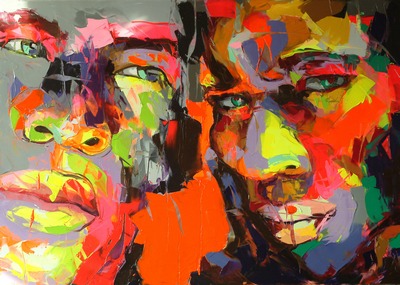THE WORK OF FRANÇOISE NIELLY
It is less than easy today to discuss figurative painting
“as such.” One inevitably encounters the question of why, in this age of
“big media” the artist has chosen to fall back on methods of representation
deemed by some to be obsolete. “These media, we learn, are reality,” writes
Robert Hughes, “and all culture had better get on board.” The traditional
method painter is forced to choose between embracing the gadgetry of our
times (a la James Rosenquist) or stubbornly refuting it by way of exclusion
(take Alice Neel). Each approach carries with it its share of dogma, and
what we are left with is a battle for representational supremacy—for the
picture of our times, and, hence, for “reality”—with the former post-technological
approach usually trumping the latter. But I would attest there is a third
category for painters who, though not unaware of this debate, approach
their own art making with a certain indifference toward such oppositions
as modern vs. post-modern; who view the technological age as neither the
“philistine counsel of despair” Hughes refers to, nor the only viable realm
from which to draw artistic source material.

Françoise Nielly is one
such artist. Though she approaches her subject with the raw psychological
intensity of Lucian Freud (the artist Hughes is defending when he speaks
of the above), her paintings unabashedly incorporate a design sensibility
which could have come from no other place but contemporary media. Working
primarily with the palette knife, Nielly is not afraid to let the rawness
of her methods dictate composition. Whimsical color choices and an unapologetic
sprightliness in her application of paint speaks to both a reverence for
her subject and for the process of painting itself. Generally working in
large format, in close to medium range to her figures, Nielly’s paintings
demonstrate focused dexterity and impulse in equal measures. Her abstract
works are like Robert Motherwell filtered through a mauve and violet lens.
Her figurative paintings reveal a decidedly feminine appreciation for the
male body, and a keen apprehension of the supercool aloofness surrounding
contemporary fashionistas. Her intersecting slabs of vibrant pigments sometimes
adhere to and sometimes shatter the Freud/Ingres maxim that the most beautiful
thing in art “is a color adjacent to another which most closely resembles
it.” The result is canvasses which one moment invoke the devil-may-care
expressivity of Chaim Soutine, and the next moment seem as though they
might be well suited for the advertisement pages of Vogue magazine. A startling
conflux of interwoven sensibilities to say the least. But, then, that is
part of Nielly’s allure.
Exhibiting in St. Tropez, Paris,
Montreal and Vancouver, Nielly’s approach carries with it the cross currents
of a cosmopolitan lifestyle. Her subjects themselves—male and female—are
as ethnically colorful as her palette (one cannot but suspect her zeal
for radiant ultramarine and sumptuous alizarin was fostered by her Riviera
upbringing). As if to further emphasize this savoir-faire internationalism,
her individual paintings—which are otherwise catalogued in the formal tradition
of “Untitled” serials—each carry with them the name of the country (France,
Canada, Dubai, Germany) in which they were created. Her most recent work
has evolved beyond the studio setting, incorporating loose fragments of
contemporary visual culture and imaginatively synthesizing her fine and
decorative arts training.
As she has matured as an artist,
Nielly has become more dazzlingly experimental in her approach while further
refining her technical mastery of the oil/knife medium. Two works from
this past year (Untitled 363 and 321) see her delving into glittering cubistic
and anthropomorphized expressions of the human form. Each is carried off
with the same unforced conflation of traditional and current visual codes
that elevates her beyond the squabbles over media and representation that
have defined our era. By apologizing for neither her less-than-faddy choice
in subject nor for the influence her culture has borne on her artistic
sensibilities, she arrives at a point much closer to the “honest” ideal
Alice Neel alludes to when she says, “I told the truth as I perceived it,
and, considering the way one is bombarded by reality, did the best and
most honest art of which I was capable.” In the case of Françoise
Nielly, it is the work that does the talking.
|

![]() © 2003-2005 Ars Interpres Publications.
© 2003-2005 Ars Interpres Publications.